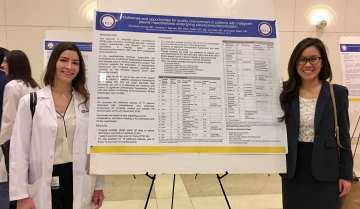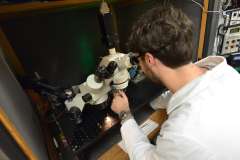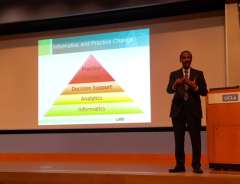Resident Scholarly Activity
We encourage and support resident scholarly activity, and the ACGME requires residents to participate in some type of scholarly activity during their four-year residency. While all residents complete at least one project by graduation, many residents are involved in more.
Resident research and publications have included:

- Quality improvement initiatives
- Basic science and translational research
- Clinical research
- Case reports
- Grand Rounds presentations
- Book chapters
The ABA allows up to 11 months of dedicated research time for four-year (categorical) residency training programs with appropriate notification of the Credentials Committee. Currently, we offer two pathways for the significant investment of resident time spent in scholarly research: the Anesthesiology Resident Research Pathway (ARRP) and the Anesthesiology Resident Scholars Pathway (ARSP).
Resident Research Projects

The department supports basic science and clinical research projects. Research opportunities are available through the department’s strong affiliation with the Division of Molecular Medicine, and we rank in the top five anesthesiology programs for NIH funding. Residents are supervised by a faculty mentor who will guide project development and implementation, as well as supervise manuscript writing and publication. Opportunities are available in clinical and translational research as well as in education and simulation research.
Elective time for research may be granted on a case-by-case basis, up to six months throughout the entire residency. Residents interested in research are encouraged to develop a project in the latter half of the CA-1 year or in the beginning of the CA-2 year so that adequate research time may be planned.
In February each year we hold our Scientific Evening, when medical students, residents, fellows, and faculty gather to present their research to the rest of the department. Prominent national faculty in anesthesiology are invited to judge the research, and prizes are awarded. This forum serves as an arena for feedback prior to presentation at national conferences. UCLA research is presented every year at national meetings including the American Society of Anesthesiologists (ASA), Society of Cardiovascular Anesthesiologists (SCA), American Society of Regional Anesthesia and Pain Medicine (ASRA), the Society of Obstetric Anesthesia and Perinatology (SOAP), and more.
Quality Improvement
Given today's emphasis on quality measures in healthcare payment models, as well as the requirement for quality improvement in Maintenance of Certification (MOCA) by the American Board of Anesthesiology, we require all residents to participate in quality initiatives. Residents participate in monthly quality assurance meetings, and in a Quality Council that develops and monitors improvement projects within the department. Some examples of recent projects, supported with faculty mentorship and department resources, include:
- Formulation of a perioperative intubation template for the EMR system

- Improved handoff processes between the OR and ICU
- Formulation of perioperative pathways for different disease processes, including anemia, diabetes, cardiac implantable electronic devices, postoperative nausea and vomiting, and coronary artery disease
Resident-inspired projects have led to new department guidelines for:
- Neuromuscular blockade monitoring and reversal, especially within the setting of end-stage renal and liver disease
- Dexmedetomidine usage in the perioperative setting
- Management of the difficult airway
- How to handle intraoperative epistaxis
- What to do in the event of dental damage
Resident-led quality improvement projects have made a genuine impact on patient care at UCLA!